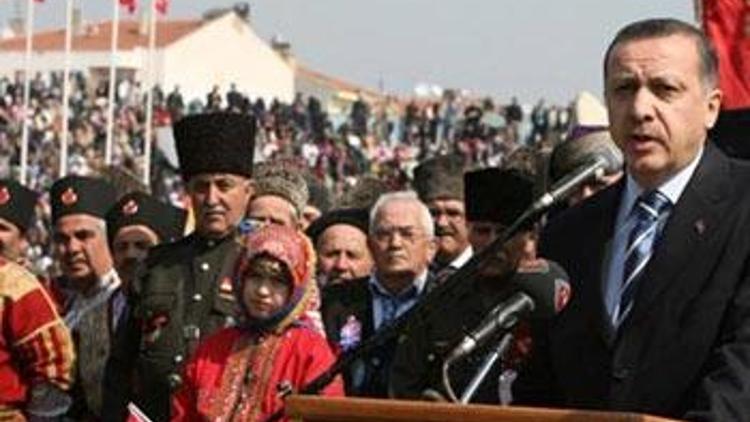PM Erdogan at The 92nd aniversary ceremony of Canakkale Naval Victory
Güncelleme Tarihi:

"Canakkale Naval Victory granted an enormous trust to Turkish people", said Prime Minister Recep Tayyip Erdogan who attended the celebration ceremony of 92th anniversary of Canakkale Naval Victory, on Sunday. Erdogan who delivered a speech at the ceremony said, Canakkale victory showed that if parties join forces for the country, they can overcome every hardship.
PM added that if the the fight for a future is made like the one in the Independence War, there cannot stand any obstacles in front of Turkish people. "The actors of this fight, which is rare in history, left us not only a
homeland, but also an independence cresset that we should always hold up in the air. The Canakkale Victory has granted enormous trust to Turkish people, showing if we join hands, we can overcome every hardship," said Erdogan. After attending the anniversary ceremony in Canakkale, PM Erdogan moved to Gelibolu (Gallipoli), where he attended to a ceremony at the Gelibolu Martyr Monument. Referring to the martyrs of the war, Erdogan said, "they showed that a nation full of dignity, faith and courage can bring the most powerful army to its
knees," adding Canakkale Naval Victory can be considered as a prologue to the Independence War.
Erdogan also reminded the words of Mustafa Kemal Ataturk, "peace at home peace in the world", saying "our philosophy as a state and nation is peace and justice." He said Turkey will continue its search for constructive and peaceful solutions to the problems in its region and around the world.
WHAT HAPPENED AT CANAKKALE STRAIT IN 1915?
During the World War I, the British officials believed that it was possible to open the Canakkale Strait "by ships only".
British commander Admiral Sackville Carden stated that he believed the strait could be forced by sufficient warships and minesweepers, in a three stage plan; first a neutralisation of the Turkish forts guarding the entrance, then a
clearing of the Turkish minefield, and finally a drive into the Sea of Marmara. This plan persuaded the War Council.
The British Navy was proud of its ammunitions, technology. It was impossible for the frayed, collapsing Ottoman Empire to withstand this invincible armada supported by French warships. Allied Armada's naval attack began on February 19th, 1915. Until March 13th, they continuously bombarded the Turkish forts and opened a way for the
minesweepers. However, they had confronted with the Turks' tough resistance. The Turkish gunners did not bother to reply the Allies' bombardment. This showed that, to open the Canakkale Strait was not that easy and the Allies could have cleaned only the first five miles of the strait. Until March 18th, the Allied Armada destroyed Seddulbahir and Ertugrul forts located on the European shore and Kumkale and Orhaniye forts located on the
Asiatic shore. It seemed that the entrance was now clear but the future was still uncertain.
On March 17th, Admiral de Robeck was in charge to proceed the plan in place of Admiral Carden. In respect of Carden's plan, the Allied Fleet appeared in the entrance in the morning of March 18th. De Robeck himself commanded the Fleet's most powerful squadron.
In bright sunshine and without the possibility of surprise, de Robeck in Queen Elizabeth led the first wave up the channel at 10.30 a.m. British ship Queen Elizabeth's target was Mecidiye fort, Lord Nelson would bomb the Namazgah fort and Inflexible's object was Hamidiye fort. This was called as "A line". De
Robeck's most powerful ships commenced to bombard the central forts.
Meanwhile, Allied Fleet entered the fire line. Turkish guns began to fire, but their guns could not cover the distance and the gunners failed to reach the ships. At midday, De Robeck signalled his second wave to go in closer.
This step of the plan was called as "B line". French commander Guepratte led his squadron through the British line and subjected the shore defences. Under Turkish gunners' heavy fire, the squadron reached the B line. After a mutual bombardment, the Allies had succeeded to stop the middle forts but the other forts continued to fire.
Turkish forts on the European shore were under a fierce fire. Most of the bombshells had hit them and destroyed the telephone lines. As the French ships had their return, something unexpected happened, around 2.00 p.m. French ship Bouvet following immediately Suffren hit a mine and within two minutes disappeared entirely, with the loss of almost all her crew. Several other ships hit mines after Bouvet in a few hours.
On March 8th, ten days before that day, Turkish minelayer Nusret had surreptitiously laid a line of mines parallel to the Asiatic shore, and now these mines were unexpectedly destroying the Allied Armada. De Robeck realised the mines and abandoned the attack. At the evening, while the second squadron was withdrawing, British ship Ocean hit a mine and exploded. The events in 18 March confused the Allies. Churchill's opponents turned out
to be right, it was impossible to open the strait "by ships only". According to Turkish sources, the Allies' total casualties are 187,000 soldiers. The Turkish causality is totally 211,000 soldiers.
The Allied Navy failed to open the straits and to capture Istanbul. Both March 18th Naval and Gelibolu (Gallipoli) land victories restored the Turkish Army's prestige. The worthiest tribute of this war to the Turkish nation is the
birth of Mustafa Kemal's military genius.

